INTRODUCTIONOpal is currently being mined from depths
between 1 metre (3 feet) and 30 metres (90 feet) below the
surface. The opal is found in sedimentary rocks that were
deposited in a freshwater environment during the Cretaceous period,
about 110 million years ago.
There are more than 200 distinct opal fields on the ridges of
Cretaceous rocks surrounding the town of Lightning
Ridge. These opal fields may be isolated or occur in
groups. The main opal field "groups" are located at Lightning
Ridge, Coocoran, Grawin/Carter's, Glengarry/Sheepyard, Wyoming, Jag
Hill and Mehi.
A number of theories, or models, exist for how opal was formed in
the Lightning Ridge region.
TYPES OF OPALPrecious
opal is the valuable form of opal which shows colourful
patterns that result from the diffraction of light in a process
similar to how the colours of a rainbow are formed. Good
quality opals will show some variation in their patterns and colours
as they are viewed from different angles, for example when they are
turned in the hand.
Potch, or common opal, is
generally of no value compared to precious opal as it does show any
diffraction of colour. Common opal occurs far more abundantly
in the opal mines than precious opals.
Both precious and common opal is found in
three major forms, or shapes;
- Nobby opal is a type of opal that is found as rounded
nodules from the size of a pea to as large as a potato.
- Seam opal is usually found as a horizontal layer, or
seam, in the opal bearing rocks.
- Fossil pseudomorphs (false forms) are plant, shell,
bone or teeth fossils which have been replaced by opal.
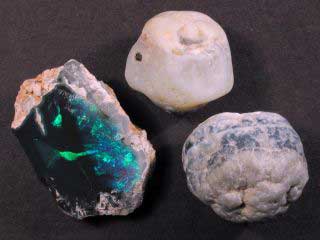 |
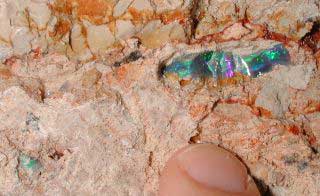 |
|
Nobby opal.
|
Seam opal.
|
THE ROCKS IN WHICH OPAL IS FOUNDMost opal is recovered from
the upper 0.3 to 0.5m of a claystone (fine grained) rock layer that
is immediately overlain by a layer of sandstone (coarser
grained). Opal tends to be more common in the claystone
layer near faults (large cracks), blows (areas of heavily fractured
rock, also know as breccia) and joints (smaller cracks) in the rock.
Currently most opal mining occurs at depths between 5m (15 feet)
and 27m (80 feet) and generally involves the extraction of a single layer of opal bearing
claystone. In some areas two or more layers may be mined.
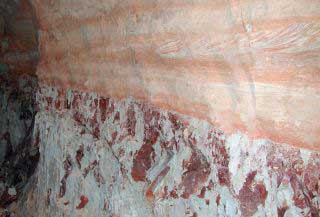 |
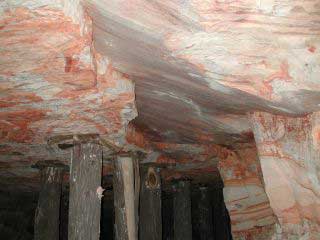 |
| Sandstone (orange) overlying opal
bearing claystone (lighter), Coocoran opal fields, Lightning Ridge. |
Fault plane (smooth surface) exposed in the
sandstone roof
of an opal mine, Coocoran opal fields, Lightning Ridge. |
|
|
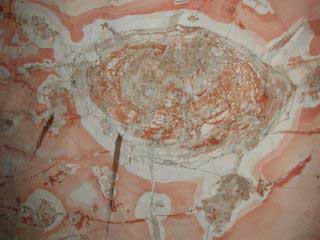 |
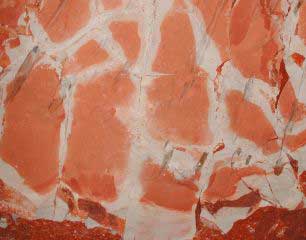 |
| Blow (light coloured circular
area) about 1.2 metres across
exposed in the sandstone roof of a mine, Coocoran opal fields, Lightning
Ridge. |
Joints (light coloured) exposed
in the sandstone roof of a mine, 3 Mile opal field, Lightning Ridge. |
AGE OF THE ROCKSOpal miners find occasional plant stems
and shells which have been opalised, usually as potch but sometimes
as precious opal. Rarer still are opalised bones and teeth of
various vertebrate animals such as turtles, lungfish, crocodiles,
pterosaurs, plesiosaurs and dinosaurs.
These and other fossils have been used to determine that the opal
bearing rocks were deposited during the Cretaceous period, about 110
million years ago, in a freshwater environment.
|
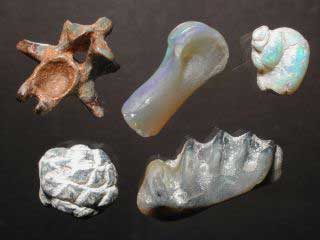
|
|
Opalised fossils, top left - turtle
vertebra, top middle - dinosaur leg bone, top right -
gastropod (water snail), bottom left - pine cone, bottom right -
lungfish tooth plate. |
HOW OPAL WAS FORMEDUnlike many other minerals, relatively
little is known about the processes involved the formation of opal
in the Lightning Ridge region. Most miners and
geologists with experience on the opal fields have their own ideas,
but these can vary widely in their nature. Currently there are
three major opal formation "models" that have a scientific
basis and some acceptance amongst opal miners, as detailed below:
(A) Deep weathering model - During
the Tertiary period the rocks which now contain opal were subject to
significant weathering. Over time small amounts of silica
tended to be leached from sandstone layers by water which then
passed through the rock until it became trapped by underlying layers
of relatively impermeable claystone. Under the right chemical
and physical conditions opal was precipitated from the water in
porous areas or voids.
There is a tendency for opal to be found close to faults in the
rock layers and near "blows" (disturbed ground). If this model
is correct then these faults and blows would have provided paths for
water containing silica to flow along.
(B) Syntectonic (Pecover) model
- Opal was deposited by heated water under pressure which originated
from underground. The water tended to flow preferentially
along faults and blows and deposit opal nearby. (C)
Microbe model - Opal bearing claystones commonly
contain substantial amounts of fine, fossilised organic matter.
Various types of microbe fossils, primarily aerobic (air
dependent) bacteria, have also been identified as fossils within
opal. Although the microbe fossils are not visible to the
naked eye, microscopic studies have shown them to be quite
abundant.
Under this model the ongoing feeding and waste production
processes of the microbes, while they were alive, created favourable
physical and chemical conditions for the formation of opal.
Ultimately each of the above models for opal formation has its
strengths and weaknesses, with more scientific research required to
clarify whether opal has formed by one process or a mixture.
MORE INFORMATIONThe following books and papers will provide
more information on the geology of the Lightning Ridge opal fields.
-
The
New Syntectonic Model of Origin to Explain The Formation of Opal
Veins,
Breccia Pipes and Faults at Lightning Ridge,
Pecover, S.R., 1999, Opal Ventures N.L., Sydney.
-
Cretaceous
Microbes – Producer of Black Opal at Lightning Ridge, NSW,
Australia, Behr, H.J., Behr, K. & Watkins, J.J., 2000
Unpublished paper.
-
Future
Prospects for Opal Mining in the Lightning Ridge Region,
Watkins, J.J., 1985, Department of Mineral Resources.
-
Black Opal Fossils of Lightning Ridge,
Smith, E. & Smith, R. 1999,
Kangaroo Press, East Roseville, NSW.
Text and pictures (C) 2002 Matthew Goodwin.
|



